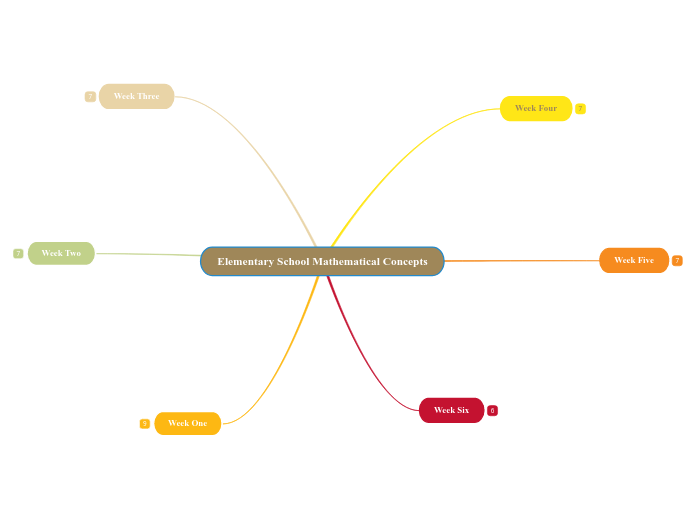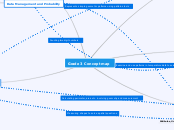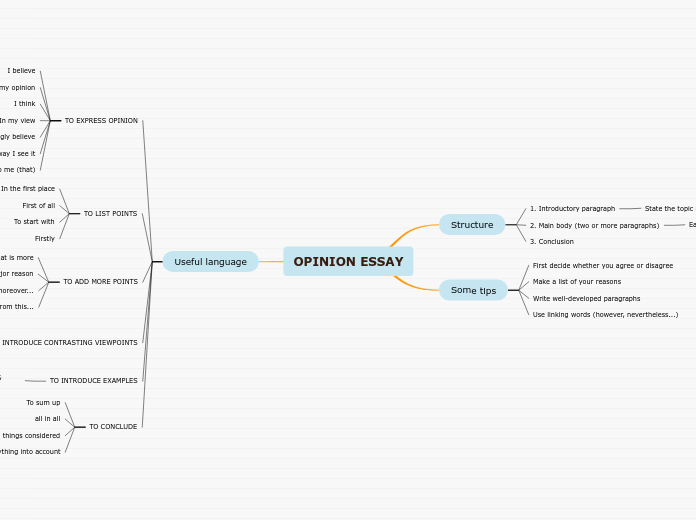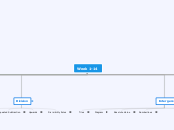Elementary School Mathematical Concepts
Week Six
Decimals
Place Value
Learning decimal place value is not as similar to whole number place value as
students would like for it to be. But it's close. Ish.
Students will first need to know the difference between 0.1 & 0.01, as this is a commonplace of confusion in the beginning stages of learning about place value; they are not the same value.
0.1 is one tenth. 0.01 is one hundredth. 0.001 is one thousandth.
Students will need to understand that the more numbers there are does not mean that the number is larger, as is the trend with positive whole numbers.
Additionally, students will learn decimal correlation to negative exponents.
For example, 34 to the negative 2 exponent equals 0.034.
Without understanding the place value of decimals, however, students may struggle to use the exponents properly without adding too many or too few zeros to their value.
Scientific Notation
Negative & Positive Exponents
Once students knows how an exponent affects a number, they will soon
learn how a negative sign, "-," affects the exponent.
We know that 10 to the second power, or ten squared, is 100. But what if it read, "10 to the -2 power"?
Students will learn that this negative sign does not make the number negative. Instead, a negative exponent indicates that the number will be a decimal.
A positive exponent does not necessarily have to be
indicated with a "+," but when first learning the concept & the differentiation
between it & the negative integer, it might be supportive to show.
Week Five
Representing Fractions
Different ways to practice identifying fractions include using a group
of various shaped, colored, or textured items to categorize as the numerator, with the total number of items being the denominator.
Identification
When discussing halves of, fourths of, sevenths of, etc., it is crucial for students to know what these phrases & terms mean.
Students must know what the numerator & the denominator represent.
For example, what does it mean if we have a third of a circle representing 1/3?
~ It means that with two more pieces, we should have a whole circle. diagrams & fractions should always be compatible & match one another.
Ex. 1/3 equals one piece, with two "missing" pieces, 2/3 equals two pieces with one "missing" piece, & 3/3 equals a whole, where there should be no "missing" pieces
Using circles, squares, & anything in-between
In the beginning of their fractional understanding, students may prefer &/or
find it easier to reference/draw circles & pie chart-type representations of fractions & percentages.
This is becasue with a circle, students are able to "see" the context of the proportions.
Addition & Subtraction
When making diagrams for fractions, things to keep in mind are consistency & clarity. Sometimes more than one graph or diagram need to be made, & that is encouraged.
*use colors*
Using diagrams are important to a student's overall understanding of the concept. It enhances their understanding of the importance of common factors, common demoniators, & size relevance.
Dividing Fractions
When using the algorithm that looks like this:
1 1
_ x _
1 1
In dividing fractions,
be sure to invert, or swap, the second fraction's numerator with the denominator in the equation, or,
the number which is being divided by.
We do this because when using this set-up, we actually are not doing any
explicit dividing; we still multiply just as we would if the equation were asking for a multiplicative product.
Therefore, inverting the second fraction is an action which requires
an opposite action.
Week Four
Fractions
Ways to make fractions compatible
How to add & subtract fractions:
If the fraction shares the same denominator...
- simply add the numerator, leaving the denominator the same
If the fraction does not share the same denominator..
- find a common denominator & repeat the action to the numerator; then, add the numerator only - simplify if needed
Vocabularly
Numerator: how many of something is being represented
Demoniator: the size of each "something"
Solving Integer Addition/Subtraction
A mini diagram should be used to help a student keep tabs, per se, on the integers in an equation.
This strategy can show students, depending on the problem, whether they should add or subtract as well as whether their answer should be positive or negative.
The idea is to still represent & keep track of the actions of the integers, using more efficient symbols.
Transitioning from Manipulatives to Diagrams
~ Once students can master the demonstration of adding positive & negative integers using manipulatives (tiles, chips), they can begin to represent these actions systematically using symbols as opposed to tangible items.
~ One way to do this is through mini diagrams.
Week One
Adding Bases
When presented with two bases to add, first
use base blocks to construct each number using
the proper base amount for each place value.
When we add in this manner, I like to think of
it as "combining."
*Similar meaning, but the
connotation helps the imagery I feel*
Once you have each number constructed,
combine all of the blocks into as many complete six base
tens columns as you can. Whatever is remaining
will be a part of the ones place.
Doing this requires some regrouping, or,
combining of ones from each number to create tens.
Count each column & record the amount of columns as the
tens place value. Do the same with the ones. Since we
regrouped by a base of six, we already know that our base
remains six.
To add bases, it is most convenient to
first make sure that the bases in which are
being added are the same. This means
that we should at least first begin to add
bases that have equal value.
Again, using base blocks for this will further
strengthen meaning & understanding as it
provides a visual & tangible action that is
happening as a representation of the
numbers & symbols.
Converting Bases
Converting bases to base ten begins with
the non-base-ten number. Using base ten blocks
is an effective way to understand this conversion/
relationship.
Let's say we are working with 23 _ base six.
First, build the number using base ten blocks.
This should result in two sets of "tens" & three blocks
in the ones place.
o o
o o This equals 23 due to the base being 6.
o o
o o o
o o o
o o o
However, to convert it to a base ten, we simply count how
many blocks exist; there are 15.
23base6 equals 15base10.
The base is relative.
Therefore, we can use bases
interchangeably as long as we understand how
to convert them.
Although it is typical to base our math
upon ten (hence, "base ten" blocks),
we can also apply the same rules to
any base. When we think about what
it means for a number to be a base
number, we are considering, in a sense,
what makes the ones, tens, & hundreds
places.
For example, if seven is the base
at-hand, comparatively to ten, 49=100.
Because...
Introduction to Base Ten Blocks
Base ten blocks are tangible
manipulatives which represent the
quantitative value of number symbols.
Typically, they are used in representation of
the ones, tens, & hundreds places.
Week Two
Introduction to Multiplication
Furthermore, 4 x 5 is not the same as 5 x 4.
Of course the answer is the same, BUT when guiding students
to a genuine understanding of what it means to multiply x by x, it is crucial that there is differentiation in the order of the variable. Diagrams effectively support the connection of these groupings.
Diagrams in the teaching & learning
of multiplication are essential for a few different
reasons.
Diagrams can be photos, drawings, or manipulatives.
Alternate Algorithms
Subtraction:
Much like addition, there are a few different
ways to systematically subtract.
Here is one of those strategies:
Addition:
Standard addition algorithm: 123+123=246
Expanded form:
*adding by place value
100+20+3
100+20+3
_________
200+40+6 = 246
Left to Right:
*add beginning with the first digits, using their appropriate value
123+123
200
40
6
______
246
Friendly numbers:
*first adding the numbers that make ten
62+28
2+8= 10
60+20=80
10+80=90
Trading off:
*transferring a key amount from one side of the
plus sign to the other to create a more simplistic
addition
75+28
(+2)73+30 = 103
Scratch:
* rounding numbers in an equation up or down to create
more easeful adding; typically done in factors of five or ten,
adding & subtracting the difference accordingly to
account for the difference
4+6+9+11=20
5+5+10+10=20
Lattice:
*using a box to separate the digits of the equation, only adding single digits, then adding the columns
2 5
+4 8
_______
0 1
6 3
7 3
Week Three
Integers
A Basic Understanding of Adding Integers:
~ What is a positive integer?
~ What is a negative integer?
~ Is 0 a positive or negative integer?
"Cancelling Out"
While this is a relatively simple term, it is essential for students to understand what it means & what the action of cancelling out does.
When adding opposite integers especially, students must be able to recognize how the value of the final product is effected & changed based upon where positive & negative integers are present.
Adding integers
Before "+" & "-" can have any meaning or explicit understanding,
students must make it tangible.
Using manipulatives such as two-colored tiles or chips is effective in
bringing this concept to life. Designating a color to positive-representing integers & the opposite to negative-representing integers aids students in actually seeing & interacting with the relationship between positive & negative integers.
Once students are taught that there are numbers less than zero, it can be incredibly challenging to "picture it." Having visuals help to demonstrate the implied number line of negative-positive.
Division
Disadvantages of Long Division
~ Students can be unsure in how to set up the problem properly.
It is easy to become unsure of which number to put inside the bracket
versus outside of it. This is due to the problem needing to be set up in
a way that is not the same as we would speak or say the problem.
_____ _____
5) 25 versus 25) 5
These problems are not the same. If the written problem is "twenty-five divided by five," it seems logical to set the problem up in the order in which we hear the words. However, this is incorrect.
Alternate Algorithms
Repeated subtraction:
~ This method might look like long divison, but it
is more practical as students get to consider factors
in using repeated subtraction.
~ Using the number in which is being divided by, find multiples
to subtract from the number being divided (the similarity to loooong
division).
~ Keep track of what numbers are being multiplied by the constant number, or the number which is being divided into; these will be necessary to add in solving for the product & remainder.









